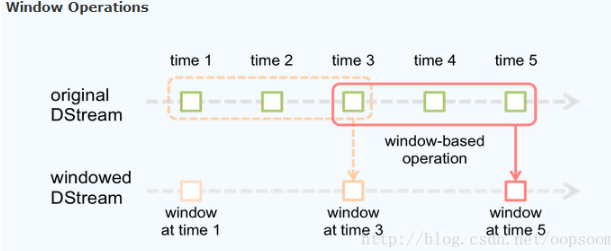最近在学习spark的相关知识, 重点在看spark streaming 和spark mllib相关的内容。
关于spark的配置: http://www.powerxing.com/spark-quick-start-guide/
这篇博客写的很全面:http://www.liuhaihua.cn/archives/134765.html
spark streaming:
是spark系统中处理流数据的分布式流处理框架,能够以最低500ms的时间间隔对流数据进行处理,延迟大概1s左右,
是一个准实时的流处理框架。
spark streaming 可以和 spark SQL、MLlib 和GraphX相结合,共同完成基于实时处理的复杂系统。
spark steaming 的原理:

如上图所示, spark streaming 将输入的数据按时间分割为若干段,每一段对应以恶spark job, 最后将处理后的任务按返回,就像流水一样。
DStram:
是 Spark Streaming 对内部持续的实时数据流的抽象描述,即我们处理的一个实时数据流,在 Spark Streaming 中对应于一个 DStream 实例,
通俗的讲Dstream 一系列是RDD的集合。
spark Streaming 编程模型:
DStream ( Discretized Stream )作为 Spark Streaming 的基础抽象,它代表持续性的数据流。这些数据流既可以通过外部输入源赖获取,也可以通过现有的 Dstream 的 transformation 操作来获得。在内部实现上, DStream 由一组时间序列上连续的 RDD 来表示。每个 RDD 都包含了自己特定时间间隔内的数据流, 如下图所示:

而对DStream 的操作,也是映射到其内部的RDD上的,如下图,通过转换操作生存新的DStram:

spark Streaming 的三种运行场景:
1. 无状态操作
2. 有状态操作(updateStateByKey)
3. window操作
接下来分别说明。

无状态操作:每次计算的时间,仅仅计算当前时间切片的内容,如,每次只计算1s时间内产生的RDD
有状态操作:不断的把当前的计算和历史时间切片的RDD进行累计,如,计算某个单词出现的次数,需要把当前的状态与历史的状态相累加,随着时间的流逝, 数据规模会越来越大
基于window的操作:针对特定的时间段,并以特定的时间间隔为单位的滑动操作,如每隔10秒,统计一下过去30秒过来的数据
如上图,红色的圈代表一个window,里面包含3个时间,并且window 每隔2个时间滑动一次,因此:
所以基于窗口的操作,需要指定2个参数:
- window length - The duration of the window (3 in the figure)
- slide interval - The interval at which the window-based operation is performed (2 in the figure).
编程实战:
官方提供的wordCount的实例:
package org.apache.spark.examples.streaming import org.apache.spark.SparkConf import org.apache.spark.streaming.{Seconds, StreamingContext} import org.apache.spark.storage.StorageLevel /** * Counts words in UTF8 encoded, ' ' delimited text received from the network every second. * * Usage: NetworkWordCount <hostname> <port> * <hostname> and <port> describe the TCP server that Spark Streaming would connect to receive data. * * To run this on your local machine, you need to first run a Netcat server * `$ nc -lk 9999` * and then run the example * `$ bin/run-example org.apache.spark.examples.streaming.NetworkWordCount localhost 9999` */ object NetworkWordCount { def main(args: Array[String]) { if (args.length < 2) { System.err.println("Usage: NetworkWordCount <hostname> <port>") System.exit(1) } StreamingExamples.setStreamingLogLevels() // Create the context with a 1 second batch size val sparkConf = new SparkConf().setAppName("NetworkWordCount") val ssc = new StreamingContext(sparkConf, Seconds(1)) // Create a socket stream on target ip:port and count the // words in input stream of delimited text (eg. generated by 'nc') // Note that no duplication in storage level only for running locally. // Replication necessary in distributed scenario for fault tolerance. val lines = ssc.socketTextStream(args(0), args(1).toInt, StorageLevel.MEMORY_AND_DISK_SER) val words = lines.flatMap(_.split(" ")) val wordCounts = words.map(x => (x, 1)).reduceByKey(_ + _) wordCounts.print() ssc.start() ssc.awaitTermination() } }
首先运行
nc -lk 9999
然后打开另一个窗口,在spark的目录下 运行
./bin/run-example streaming.NetworkWordCount localhost 9999